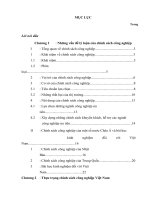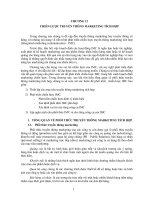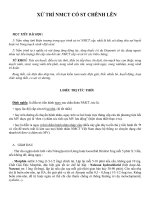Chiến lược tái thông mạch vành hiện nay cho NMCT cấp ST chênh lên
Bạn đang xem bản rút gọn của tài liệu. Xem và tải ngay bản đầy đủ của tài liệu tại đây (2.22 MB, 28 trang )
15th National Congress of Cardiology
Hanoi, Vietnam, October 9-11, 2016
Contemporary Strategies for
Percutaneous Reperfusion in STEMI
2016
Gregory W. Barsness, MD, FACC, FAHA, FSCAI
Consultant, Mayo Clinic Departments of Cardiovascular Diseases and Radiology
Director, Mayo Clinic CICU
©2014 MFMER | Slide-1
Ischemic Heart Disease in Vietnam
Growing and Costly Problem
In 2011:
38% of Deaths related to CV Disease
23% of Deaths from Stroke
15% of Death attributable to Coronary Disease
By 2017:
20% prevalence of CV Disease and HTN
WHO Report 2011
Data from 2016 Pacific Cross Vietnam (Blue Cross Vietnam)
©2014 MFMER | Slide-2
All-Cause Long-Term Mortality in ACS
4606 AMI Pts Undergoing Angiography
70
Mortality (%)
60
NSTEMI
50
40
30
STEMI
20
10
0
0
1
2
3
4
Years
5
6
7
8
Chan, et al. Circ 2009;119
©2014 MFMER | Slide-3
6-Month Mortality Following ACS
GRACE
(n=43,810)
Fox, et al. BMJ 2006
©2014 MFMER | Slide-4
Guideline Adherence and Outcome
In-hosp mortality (%)
7
6
5.95
6.33
5.16
5
4
3
5.07
4.97
Adjusted
Unadjusted
4.63
4.16
4.17
Every 10% in guidelines adherence
2
11% in mortality
1
0
<=25%
25-50%
50-75%
>=75%
Hospital composite quality quartiles
Peterson, et al. ACC 2004
©2014 MFMER | Slide-5
Hospital Performance and Outcome
Mean Life Expectancy After AMI
119,735 AMI Patients in Cooperative Cardiovascular Project (1994-97)
>1 Year Longer Life Expectancy!
Bucholz, et al. NEJM 2016;375 (14)
©2014 MFMER | Slide-6
STEMI Management Algorithm
Www.
www.cardiosource.org
©2014 MFMER | Slide-10
35-Day Mortality Reduction with Thrombolysis
58,600 Patients in 9 Randomized Trials
30
Mortality (%)
P<0.00001
18%
reduction
Lytic
Thrombosis
Placebo
Placebo
23.6
18.7
20
16.9
13.4
13.2
11.5
10
NNT
15.2
13.8
10.6
9.6
7.5
8.4
50
20
27
111
33
Total
BBB
Ant MI
Inf MI
Other
ST
ST -
0
ST
¯
FTT: Lancet, 1994
©2014 MFMER | Slide-11
Primary PCI vs. Fibrinolysis
Meta-analysis of 23 RCTs of 7739 pts
NNT = 50
NNT = 17
4-6 week outcomes
25
21
PCI
20
Lysis
15
%
10
13
7
9
5
7
7
6
2.2
1
2
0
Death
Re-MI
Rec
Isch
Total
stroke
0
8
5
1
Hem
stroke
Major
bleed
Death
MI
Stroke
Keeley and Grines. Lancet 2003
©2014 MFMER | Slide-17
Time to Reperfusion
Effectiveness of Thrombolysis and PPCI
PCI
Thrombolysis
Benefit
Benefit
< 2 Hours
> 2 Hours
Lysis or PPCI
PPCI
Risk
Risk
Time
Time
Consider Pharmaco-Invasive Approach
©2014 MFMER | Slide-18
“The Problem of Time”
80
1st
60
Greatest benefit in
40
Minimal additional
benefit after 3 hours
hr
20
1-yr Mortality (%)
Abs. Survival Benefit (per 1000
patients)
12
10
8
Each 30 min delay in
PPCI = 7.5% relative
increase in 1 year
mortality
6
4
2
0
0
3
6
9
12
15
Ischemic
Time (h)
Circulation 2004;109:1223
JAMA 2005;293:979-86
18
21
25
60
120
180
240
300
360
Ischemic
Time (Min)
©2014 MFMER | Slide-19
Absolute Risk Difference PCI vs Lytic (%)
Survival Benefits of Primary PCI and Time
15
10
>60 minute
Delay results in
no survival
benefit for
primary PCI
5
0
-5
20
40
60
80
100
DTB-DTN time (min)
AJC 2003;92:824
©2014 MFMER | Slide-21
Pharmaco-Invasive Strategy for STEMI
Importance of Medications and Timing
Pharmaco-Invasive
Lysis
+ clopidogrel
Transfer to CCU
Urgent/routine elective
Angio/PCI 3-24 hours
(Class IIa)
©2014 MFMER | Slide-28
1-Year Mortality in STREAM
Pharmaco-Invasive vs PPCI (n=1892)
Inclusion:
Symptoms <3 hours
PPCI > 1 hour
2 mm STE
PreHospital lytic eligible
Sinnaeve et al. Circulation 2014;130:1139.
©2014 MFMER | Slide-31
Pharmaco-Invasive vs PPCI Strategy
1216 Patients in Regional STEMI System (2009-11)
8
PharmacoInvasive
PPCI
6
%
4
All p=NS
2
0
Death/MI/CVA
Death
PPCI mean D2B=95 min
Stroke
Maj. Bleeding
PI mean D2N=31 min
Rashid, et al. JACC Card Int 2016;9:2014
©2014 MFMER | Slide-32
Reperfusion Strategy
No
Lytic
Eligible?
Transfer for
Primary PCI
Anticipated
Time from
FMC to PCI
Acceptable
Bleeding Risk?
Yes
PARAMEDIC
UNIT
23 5
Time of Symptoms
<3 Hours
3-12 Hours
<120
Minutes
Transfer for
Primary PCI
Transfer for
Primary PCI
>120
Minutes
Lytics and
Transfer
?
©2014 MFMER | Slide-34
©2014 MFMER | Slide-36
Access Choice in Stable Syndromes and ACS
Pooled Analysis of All-Cause Death
Ferrante et al. JACC CV Int 2016;9:1419
©2014 MFMER | Slide-42
Recent Trials of Complete Revascularization
in STEMI
Complete vs Culprit-Only
Complete Culprit-Only
Better
Better
Binder et al. Eur Heart J. 2016;37:217-220
©2014 MFMER | Slide-45
Recent Trials of Complete Revascularization
in STEMI
Ad hoc Complete vs Staged Complete
48/44
65/65
46/43
159/152
Binder et al. Eur Heart J. 2016;37:217-220
©2014 MFMER | Slide-46
Ischemia Evaluation in ACS
FFR Remote to Culprit Lesion
• 101 with MV disease
• 75 STEMI + 26 NSTEMI
• Stable hemodynamics
• FFR of remote lesion
during acute phase and
median 27 days later
No significant change
from acute phase to
early follow-up
Ntalianis A: JACC CV Intv 2010
©2014 MFMER | Slide-47
FAMOUS-NSTEMI
FFR- vs Angiography-Guided Management
350 NSTEMI with at least 1 lesion ≥30% stenosis
FFR Disclosure modified treatment choice in 21.6%
Similar MACE with 8% lower revascularization rates
MACE
But lesion deferral in ACS controversial
(Especially of presumed culprit lesion)
DANAMI 3-PRIMULTI trial demonstrated safety and
feasibility of FFR in STEMI patients w/in 2 days
Layland, et al. EHJ 2015;36:100
Hakeem, et al. JACC 2016;68:1181
©2014 MFMER | Slide-48
BMS vs PTCA in AMI
Meta-Analysis of 13 RCT (n=6922)
De Luca et al. Int J Card 2007;119:306
©2014 MFMER | Slide-49
EXAMINATION Trial
2-Year Outcome Xience V (EES) vs Vision (BMS)
PCI within 48 hours (85% PPCI within 12 hr) for STEMI
Sabate et al. JACC CV Int 2014; 7:64
©2014 MFMER | Slide-50
Jolly et al. Lancet 2015
Higuma JACC Card Int 2016;8:2002
©2014 MFMER | Slide-54









